Flag Art: Raising New Symbols of Belonging
November 19, 2020 / 0 Comments
As the end to a most trying year draws near, hopes for a fairer and more equitable future are weighted against the injustices of the present that attempt to erode the very foundations of our democracy. Even in the wake of the U.S. election’s positive outcome, conservative politicians and right-wing extremists, cloaked in the guise of patriotism, continue to exploit symbols of freedom, including the American flag, to bolster a dangerous authoritarian nationalism and commit atrocities against American citizens, immigrants, indigenous peoples, and Earth.
Fraught with a myriad of conflicting meanings, the American flag is a symbol of both freedom and oppression, filled with promises – some realized, others unfulfilled. And yet, it continues to incite passion for the principles it purports to uphold and for those who have fought on their behalf. When activist Abbie Hoffman appeared before the House Un-American Activities Committee in 1968 wearing a button-down shirt patterned with the Stars-and-Stripes, the shirt was torn from his back and he was arrested for desecration of the American flag. (The conviction was later overturned.) “I only regret that I have but one shirt to give for my country,” Hoffman proclaimed, channeling Revolutionary War patriot Nathan Hale. During the political events of 1968, the protest and countercultural movements of the decade reclaimed the American flag as an emblem of free speech and a banner for peace during the Vietnam War. A year later at Woodstock, the flag appeared on bikinis, bell bottoms, and Joe Cocker’s platform shoes, while Richie Haven’s improvisational anthem “Freedom” and Jimi Hendrix’s dissonant version of “The Star-Spangled Banner” gave new expressive forms to the flag’s representative ideals.
Today’s Black Lives Matter movement and protests against police violence have renewed debates about historical markers and symbols of oppression, toppling contested monuments and calling for the removal of Confederate flags across the American South. In response, the Mississippi state flag, which bore a Confederate symbol, was retired in June, and a new design with the image of a magnolia (the state flower) surrounded by a ring of stars was voted on and accepted November 3rd. What has emerged from our current political discord is a fundamental rethinking of how, who, and what we commemorate. Frayed by the burdens of the past, can the American flag truly embody the many conflicts fought in the name of freedom and yet to be won? How can a simple rectangular swath of cloth hold all that history (and hope) in one graphic form? Artists and cultural institutions have raised similar questions in a number of recent public art projects that challenge the function and meaning of flags, while reimagining flags as symbols that expand beyond national identity and geographic borders.
Many initiated during the restrictions imposed because of Covid-19, these flag projects employ interventionist strategies that activate their respective sites, creating chance encounters that solicit viewers and casual passersby to contemplate the urgent political and cultural issues of our time as we cautiously navigate our public spaces. Thus, blind patriotism and universal ideals give way to a civic art that celebrates diverse citizenry and aesthetic ideas through an easily accessible form that simultaneously critiques the rituals of power for which flags are flown.
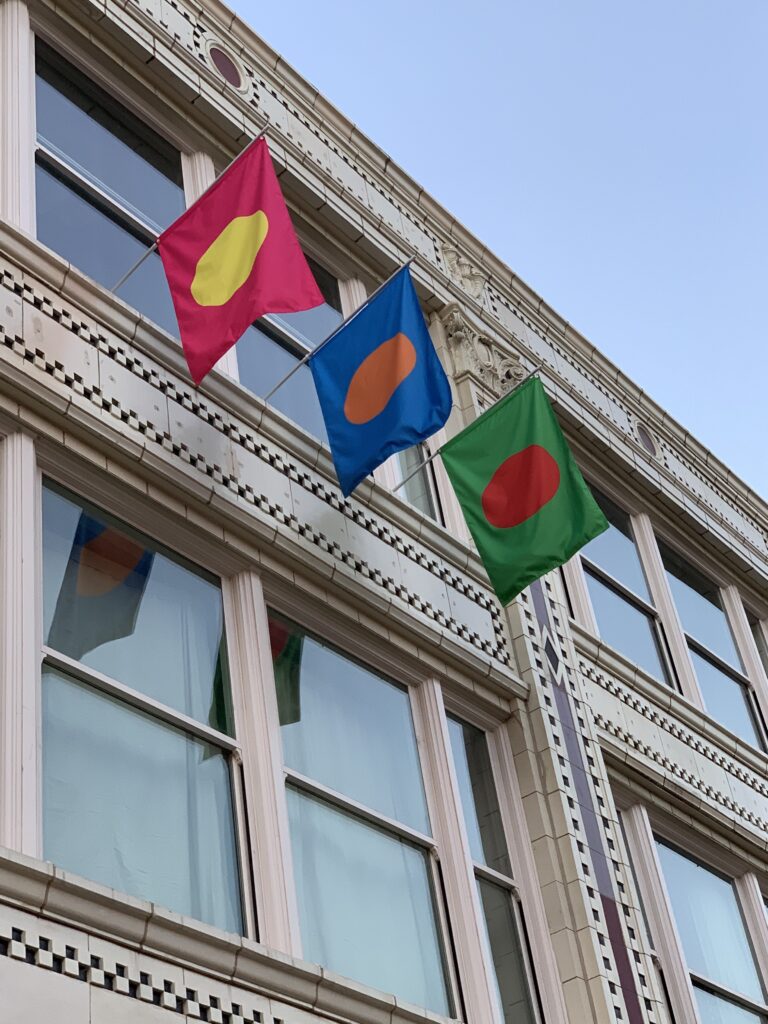
SOS Color Code 2020, by the Chicago-based collaborative Luftwerk and graphic design practice Normal, recast the Morse Code SOS sequence in their series of colorful geometric flags that signaled distress across twelve partner sites, including Chicago, Pittsburgh, Kasas City, Tampa, and St. Paul. Created in response to the current pandemic and police protests ignited by the murder of George Floyd, SOS Color Code prompted both a cry for help and a signal for action, a kind of call and response, as well as a collective gesture of solidarity. The signal’s familiar dashes and dots were translated into a pattern of elemental forms within pulsating fields of complementary colors (red/green, blue/orange, magenta/yellow), with each flag marked with a dot on one side and a dash on the other then installed in formations of three to emulate the three-character code.
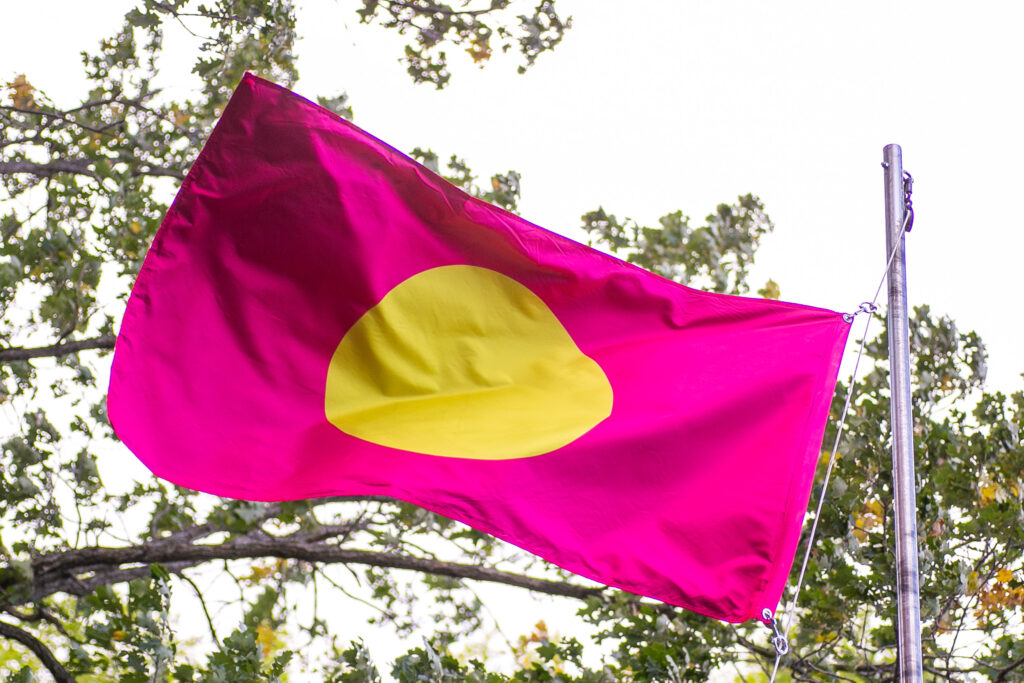
Reminiscent of the paintings of Josef Albers, Elsworth Kelly, and Kenneth Noland, the flags’ vibrant compositions purposefully exploit the visual and sensory effects of color to engage viewers in an optical play that reveal truths beyond what is initially perceived. Albers saw the political potential of color, as noted in a review of his book Interactions of Color (1963): “In an age in which increased human sensibility has become such an obvious need in all areas of human involvement, color sensitivity and awareness can constitute a major weapon against forces of insensitivity and brutalization.” (Note 1)
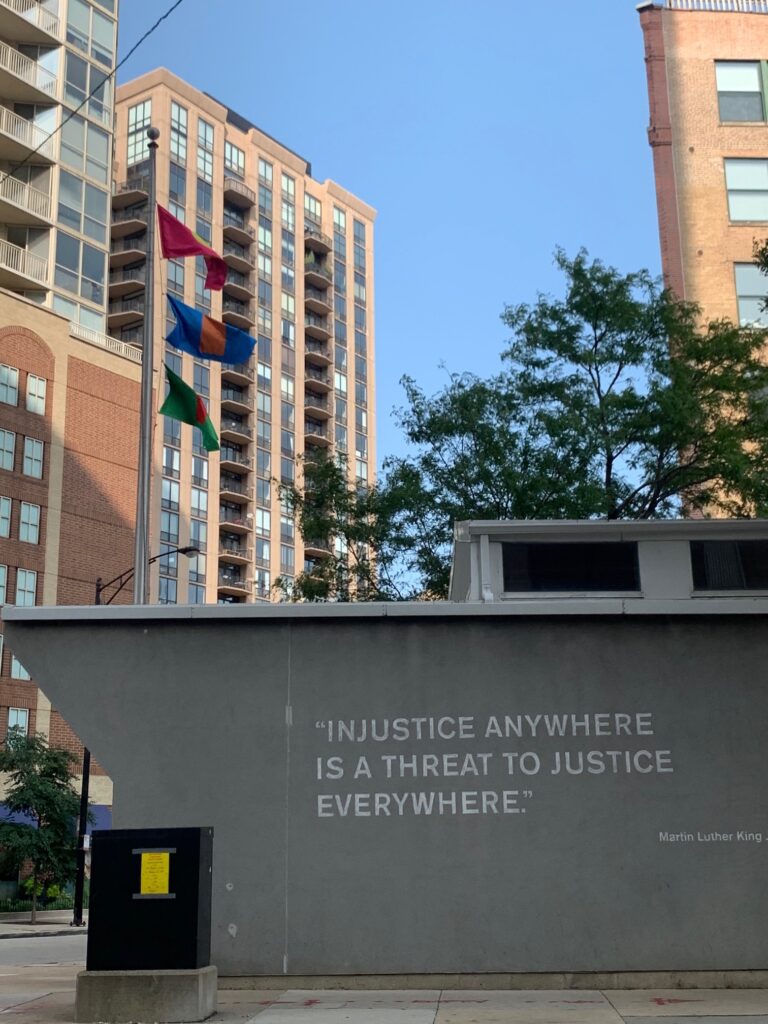
For me, experiencing SOS Color Code as it was installed outside the National Public Housing Museum in Chicago reinforced the project’s use of systems of color to speak to systems of injustice, in particular those that disproportionately affect the homeless and communities of color. At the same time, the flags operate critically as signs of protest against abuses and failures of power (police, presidential, and other), and as forms of alternative messaging that calls for action, unity, and collective care.
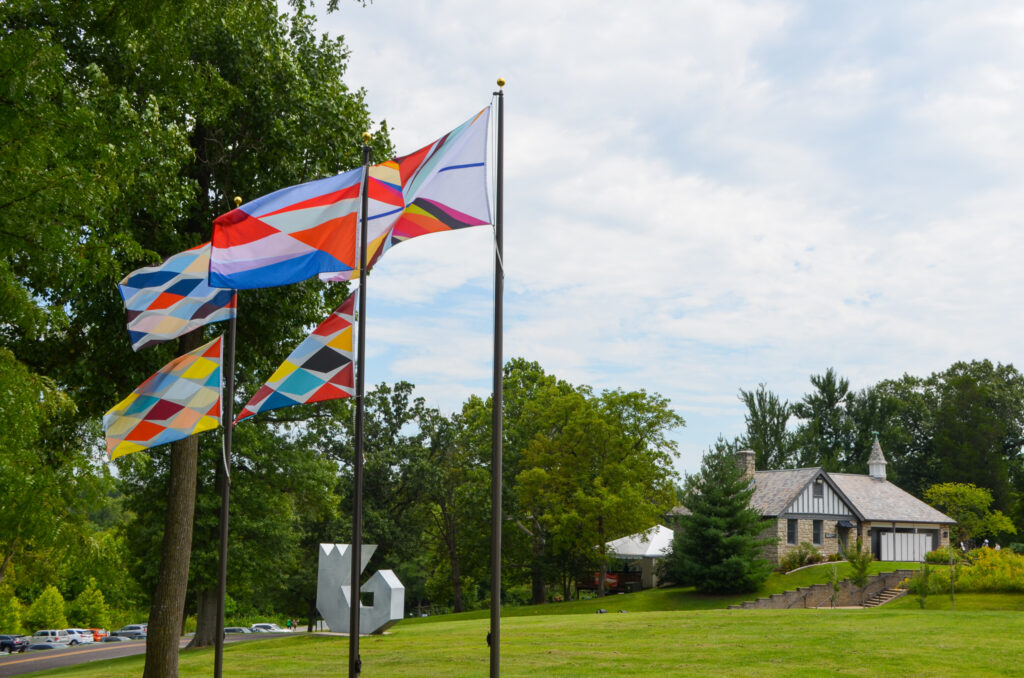
The Nigerian-born, Philadelphia-based artist Odili Donald Odita similarly employs color and abstraction to address issues of inequity and social justice in his flag series From Periphery to Center, a public art project commissioned by the Laumeier Sculpture Park in St. Louis. A meditation on place, this series of fifteen nylon flags is installed in two locations: at Laumeier, in North St. Louis County and at the Jeske Sculpture Park in nearby Ferguson to the north, where the fatal shooting of Michael Brown by a white police officer in 2014 incited social unrest and brought worldwide attention to this predominately black community. Odita symbolically renders the social and geographic relationship between these two disparate places in five unique flag designs using the bold geometry and contrasting hues that have defined his paintings. In X (Laumeier), for example, two brightly banded pyramids converge at a horizontal blue line as if to meet on common ground, while in three flags titled Fence, the push-pull effect of a dazzling chain-link pattern suggests both division and unity. In addition to their function as geographic markers, each flag blurs the distinction between margins and borders (the periphery and center of the project’s title) to map spatial territories in which the associative powers of color and form offer new ways of seeing.
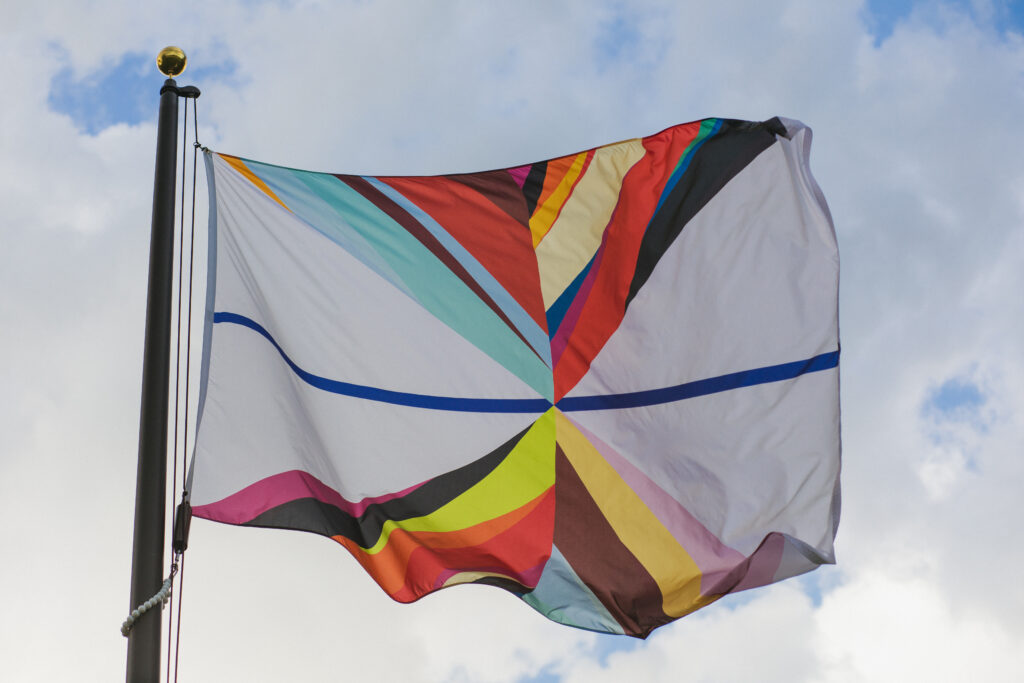
Odita has deployed flags in his previous public works, including for Prospect 4 (2017-18), New Orleans’s triennial of contemporary art. Here, the artist installed flags across the city in public spaces related to histories of slavery and civil rights, the designs of which share formal affinities with those created for the St. Louis exhibition. However beyond their common vocabulary and chromatic forms, each project, each flag is uniquely its own, as the artist’s colors are derived intuitively and from researching the history of a given site. Thus for Odita, color functions site-specifically:
“At one point I wanted to use African colors when I was painting and talk about Africa. I know now that that is the most ridiculous idea because how do you define that? Like, American colors? There is the American flag, but another country might use a similar palette for their flag. It’s really about understanding how we renew and re-imagine ourselves in the world in a way so that we reach our full potentials. We just have to understand how things are very specific: time, geography, and location. There is no absolute.” (Note 2)
Central to these artists’ projects is the creation of alternative iconographies of place that challenge the worn absolutisms of mainstream democracy and make visible the realities and conflicts of civic life. As such, artists’ flags (Flag Art?) are potent symbols of protest and placemakers for impromptu social engagement. When raised within our public spaces (whether in outdoor plazas and public parks, or on flagpoles and the exteriors of buildings), they contest the institutions of power that control the public sphere, transforming the physical environments they occupy into spaces for discussion and debate.
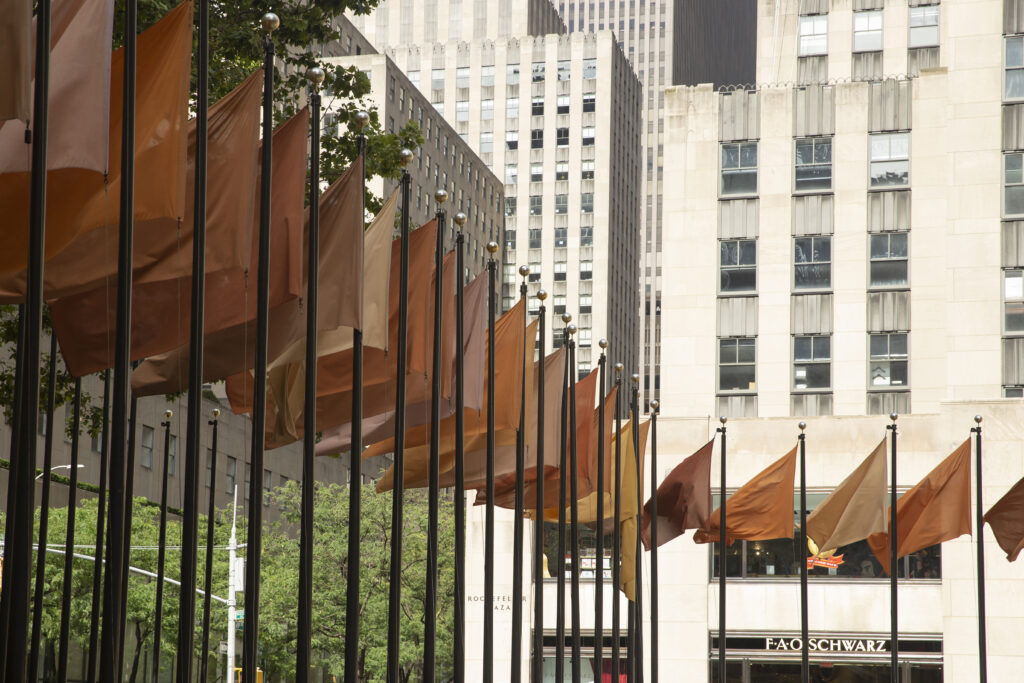
Rockefeller Center, New York City. September 1-October 2, 2020. Photograph: Jon
Cancro.
Flag Art is, then, both a social practice and a spatial one. For Andy Goldsworthy, it is also an environmental practice, as evinced in his project Red Flags, recently on view at Rockefeller Center in New York as part of Frieze Sculpture. This past fall, the artist replaced the United Nations flags that encircle the Lower Plaza’s iconic skating rink with 109 cloth flags stained with soil culled from each of the fifty U.S. states. United in hue yet displaying remarkable variation (at least in documentation) – from russet to rust to umber – Red Flags salves the ideological divisions that define our political present by offering a portrait of the United States as a diverse nation of shared lands.
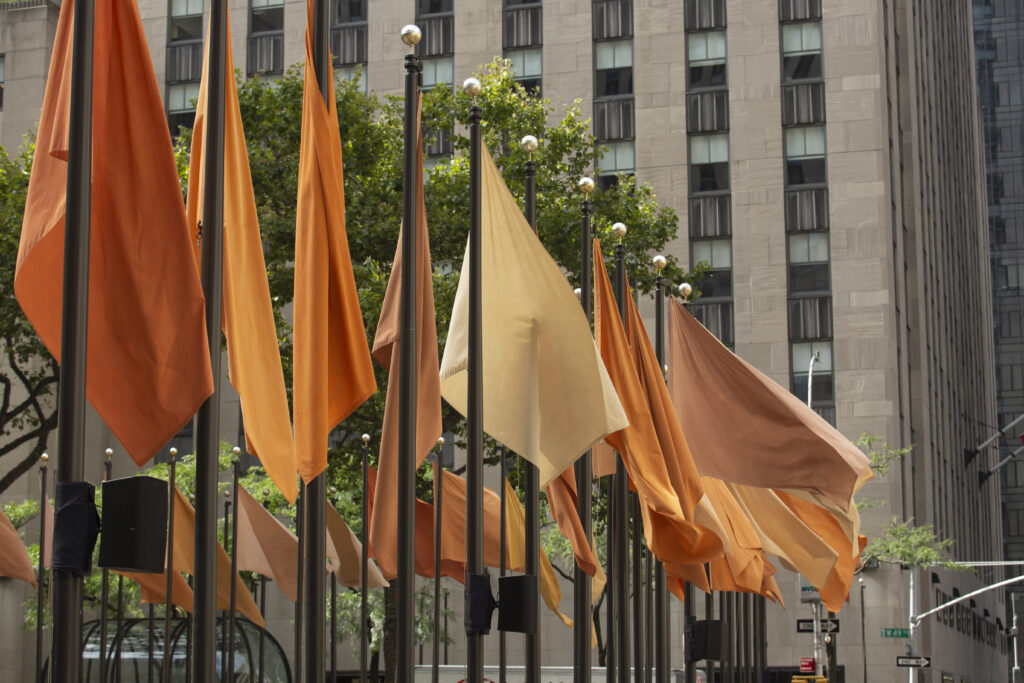
Rockefeller Center, New York City. September 1-October 2, 2020. Photograph: Jon
Cancro.
Goldsworthy started gathering soil for Red Flags in September 2019 while completing another work, Walking Wall, an ambling stone wall installed at the Nelson-Atkins Museum of Art in Kansas City. After restrictions imposed because of Covid-19 made it difficult to complete the Red Flags project as envisioned, Goldsworthy asked others to excavate red earth from the remaining states then send it to his studio in Scotland. At once collaborative yet true to his environmental practice in which the artist’s own body and experience in nature is as integral to the work as the physical artifact, Goldsworthy applied the collected soils to the surfaces of the blank canvas flags by hand. Just as human interaction with nature is central to the realization of his large-scale installations, so too is the work’s own engagement with the natural and atmospheric conditions of its site. For Red Flags, this includes rain, wind, shadow, and light: when the air is still, the flags hang limp and calm; when the wind blusters and blows, they wave proudly unfurled. Never static, but rather poised in a continuous flow of motion and rest, Red Flags appropriates the titular sign of warning “to mark a different kind of defense of the land,” states the artist, one that “will rise above individual states” and reconnect citizens to the natural environment they live in. (Note 3)
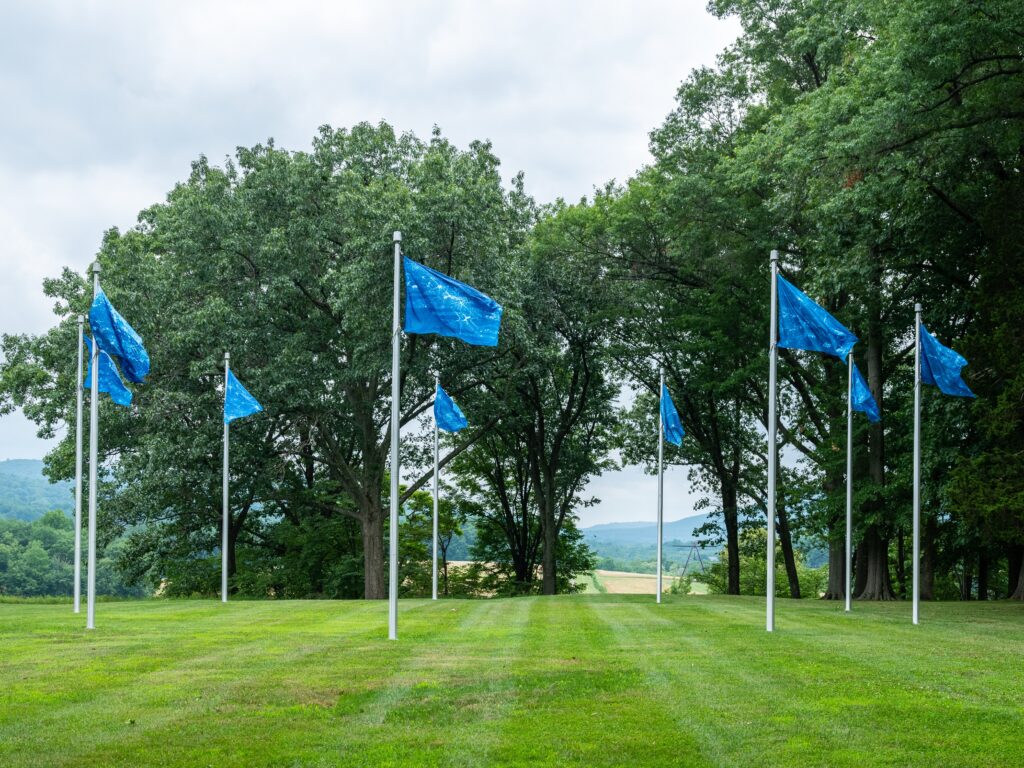
Landscape, movement, and light are also the essentials themes of Kiki Smith’s River Light, a circular procession of nine flags based on the artist’s ongoing fascination with the East River, recently on view at Storm King Art Center in upstate New York. The flags’ blue-and-white images are based on stills from a film created by Smith that records shimmers of sunlight upon the undulating surface of the river. The film stills were transferred to Plexiglas plates, then translated as cyanotypes, and finally printed on silk-and-polyester fields. The resultant flags (each measuring 7’ 6” x 10’) retain the brilliant blue (cyan) hue of the photographic print, while capturing the luminescence of the river from which they are inspired. (A related, standalone flag displayed the photographic image of the Hudson River at sunset, in which the blurred silhouette of a tree shadows a purple and orange horizon.)
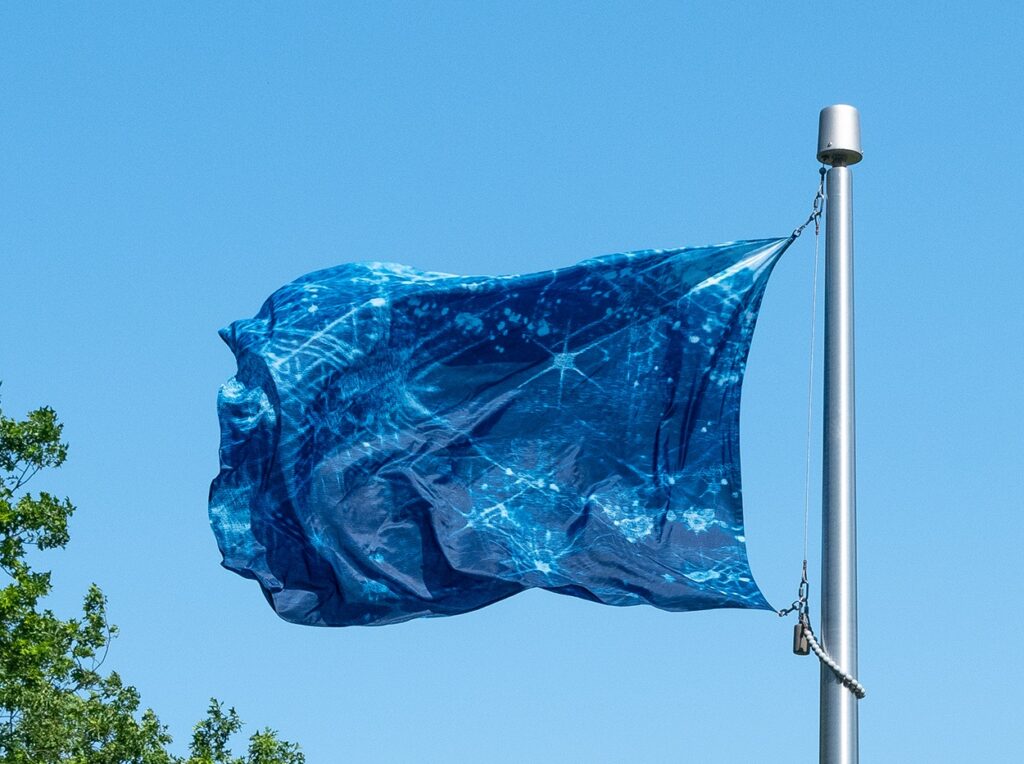
Although somewhat detached from the issues of civic engagement that define the other projects I am discussing here, River Light configures landscape as something iconic, while exploiting the unique properties of flags. According to Smith, “The American Flag is very successful because of its stripes, as opposed to different kinds of patterning, which allows you to see the undulation of the flag . . . .That it’s constantly moving and changing and not repeating itself [is] a unique thing to flags.” (Note 4) Like Goldsworthy’s Red Flags, River Light is activated by the forces of nature and the outdoor environment of Storm King, the flags movement emulating the ebb and flow of their watery sources at the same time animating its dramatic hillside site.
Active, pliant, and temporal, Flag Art counters the monumental stasis of historical monuments and public sculpture yet offers potent public symbols through emblematic graphic and textile forms. As equally grounded in conceptual and material art practices as in the history of protest and civic life, Flag Art has its own legacy in contemporary art. David Hammons’ African-American Flag (1980) – in which the artist replaced the red, white and blue of the American flag with the black, red and green of activist Marcus Garvey’s Pan-African flag – has become an iconic symbol of Black cultural identity. William Pope.L’s Trinket (2008/2015), a colossal American flag whose frayed stripes billow in winds created by a series of industrial fans, speaks to hollowed allegiances while, in the artist’s words, “bestowing the flag with an inner life.” (Note 5)
These material expressions question and reframe our democratic ideals within the museum or gallery context, yet still ignite the political imagination, a testament to the power they hold. When artist Dread Scott placed an American flag on the floor of a gallery at the School of the Art Institute of Chicago in 1989, such ideals were tested. This participatory work asked viewers the titular question “What Is the Proper Way to Display the American Flag?” Viewers recorded their responses in blank books on a nearby shelf, positioned so that they could stand on the flag while they wrote. The work became immediately embroiled in the public controversaries and political theater that would define the Cultural Wars, in which the artist’s First Amendment Rights were challenged but ultimately upheld.
Scott has continued to decry the false absolutes of American patriotism alongside abuses to constitutional and civic rights in subsequent works, many including flags. In 2015 and in response to the murder of Walter Scott by South Carolina police, the artist updated the NAACP flag with the words “A black man was lynched by police yesterday,” rendered in crisp white letters against a black fabric field. Connecting histories of racial injustice to those of the present, the work is mordant reminder of how sanctioned systems of violence continue to oppress — its message even more resonant within the context of the police murder of George Floyd.
Today’s Flag Art builds on the legacies of these and other works to address issues of citizenship, nationhood, and historical memory, as in Sonya Clark’s monumental linen replica of the Confederate truce flag and Stephanie Syjuco’s Rogue States (2018), fictional flags created for imaginary countries demonized in Western-made films. Pledges of Allegiance (2018), a year-long public art project organized by Creative Time, commissioned 16 national and international artists to “raise flags as art” in 34 sites across the United States. Embracing flags as powerful emblems of protest and free speech, artists imagined a more pluralistic set of allegiances to those sullied by the tribalism and divisive politics of recent years, with themes ranging from immigration rights to water justice for Flint, Michigan.
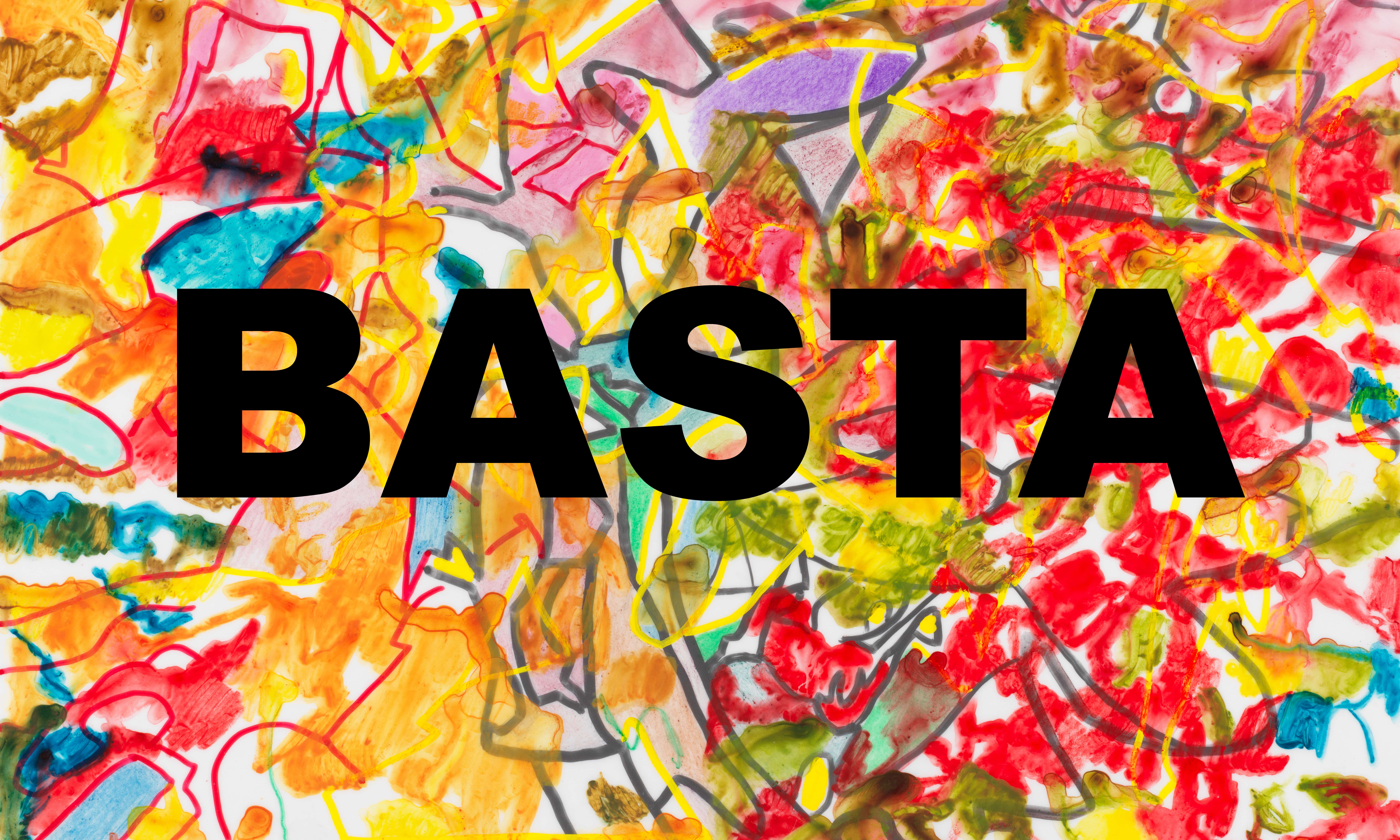
The international project Four Flags similarly celebrated the expressive properties of flags, producing a communal form of art to help support and promote artists in public spaces during the isolation of Covid-19. Flags by 35 Chicago-based artists were exhibited on a rotating basis on the façade of the gallery Chicago Manual of Style – the only U.S. venue for the project that also included sites in Amsterdam, Belgium, Germany, Colombia, and Brazil – then sold in limited editions. Works by Candida Alvarez, Barbara Kasten, and Maryam Taghavi were raised on the day that I stood outside the gallery looking upward, their cloth forms waving proudly against a clear blue sky. United in purpose and by a shared interest in spatial explorations through color and a personally derived abstraction (and in the case of Taghavi, text), their works signaled a sense of unrest: Kasten’s shardlike triangular planes suggest a fractured world; Taghavi’s layered typography spells “Fire” in Arabic. Alvarez’s flag bears a multihued pattern of interlocking organic forms upon which the artist has scripted the declarative “BASTA” (Spanish for ENOUGH) in bold black letters. On November 3rd, her plea for unity and resolution was partially answered.
Expanding the concept of place through popular material and political forms, the artists’ flags I have described here configure new symbols of belonging. Both works of art and acts of resistance, Flag Art belongs to the larger lexicon of visual culture and civic engagement that celebrates plurality and difference as it defends democracy and freedom for all.
Notes
- This quote is by an unnamed reviewer, whose observation Josef Albers embraced. See Ivy Sanders Schneider, “Spotlight on Josef and Anni Albers,” in Yale University Press Blog, March 24, 2017: http://blog.yalebooks.com/2017/03/24/spotlight-on-josef-and-anni-albers/
- Odili Donald Odita in an interview with Adam Lehrer, “Artist Odili Donald Odita Emphasizes Human Discrepancies Through Color and Lines at Jack Shainman,” in Forbes, Feb. 10, 2016. See: https://www.forbes.com/sites/adamlehrer/2016/02/10/artist-odili-donald-odita-emphasizes-human-discrepancies-through-color-and-lines-at-jack-shainman/?sh=500e4f0d8edf
- Andy Goldsworthy as stated in press materials from Galerie Lelong. See: https://www.galerielelong.com/attachment/en/57eac8ed87aa2c6e4b7d0574/News/5f21d2b23cc1382d0e7f6886
- Kiki Smith in an interview with Nora Lawrence published by Storm King Art Center, May 11, 2020. See: https://collections.stormking.org/Detail/archival/7335
- William Pope.L in a statement from video “William Pope.L: Trinket” produced by The Geffen Contemporary at MOCA, Los Angeles: https://www.moca.org/exhibition/william-popel-trinket